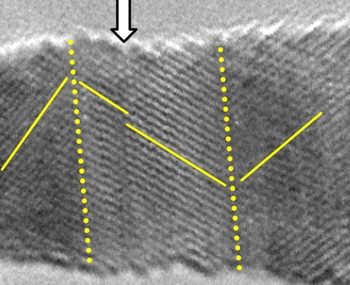Rice University scientist Jun Lou and his team have discovered that gold wires have reduced ductility at the nanoscale. This finding has been reported in the Advanced Functional Materials journal.
In the paper, the research team described its findings about gold nanowires when they were subjected to stresses they experience practically in applications such as flexible electronics utilizing atomic force microscope or transmission electron microscope.
 A single crystal nanowire shows evidence of twinning under tensile loading
A single crystal nanowire shows evidence of twinning under tensile loading
Lou team had already proved that metal wires at the nanoscale demonstrate unique properties. They determined these nanowires experience ‘necking’ when stress was applied on them. i.e., they deform in a certain region and then extend to a point prior to which they finally break.
Lou stated that when his team subjected the gold nanowires to stress in a slightly different manner, they formed a defect known as a twin. The term ‘twinning’ is derived from the defect’s mirror-like atomic pattern that is characteristic to crystals. When observed under an electron microscope, the team noticed twins in nanowires as dark lines throughout the wire. Twins occurred under the shear factor of the stress, which triggered atoms to move towards the site of surface defects to create a type of nanoscale tectonic defect throughout the wire.
Lou said that the formation of such damage-triggering sites in the nanowires makes them less ductile and cause them to break prematurely. It is not possible to arrange the grip points on each side of the nanowire using existing technology. Hence, the nanowires cannot be avoided from facing shear force.
Lou further commented that the findings are critical to producers planning to utilize gold as a nanomechanical component. Practically, the formation of twins due to certain off-axis angle of stress would result in less ductility, which would lead to the modification of design criteria, he said. The finding opens door for industry to witness the application of nanowires made of platinum, palladium, tellurium, silver and gold in future-generation nanoelectronic devices.